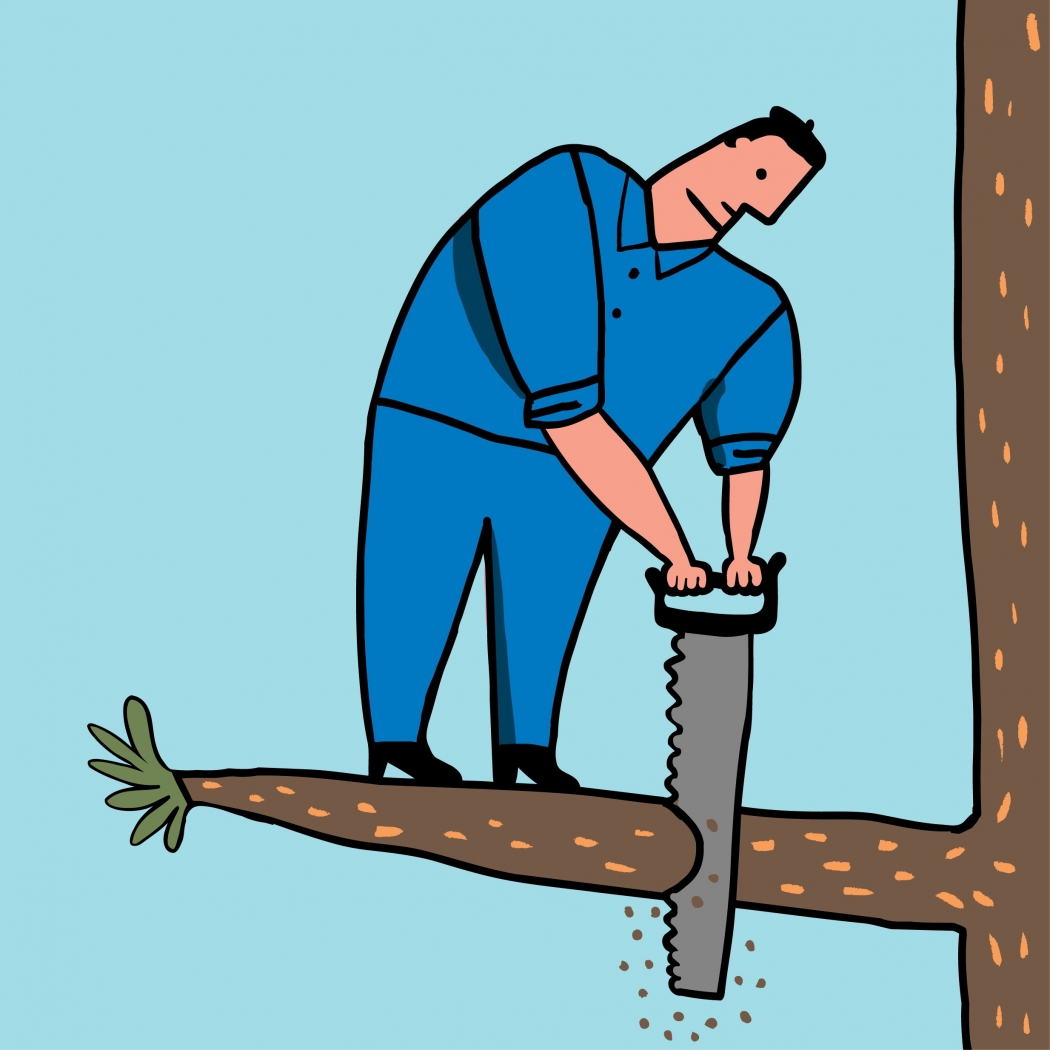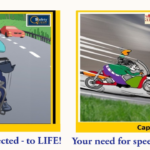When it comes to road safety, the risks are often conveyed in terms of statistics. Yet, despite losing over 400 people every day on Indian roads, our road users seem to judge risk quite differently. We tend to minimize personal risk due to unrealistic optimism and an over-estimation of our driving abilities, leading to perceived invulnerability. But things can turn topsy turvy in a split second!
I Feel It’s Safe!
Take a look at the pics below. Each depicts a risky behaviour. Overspeeding, overtaking on a curve at high speed, jumping lights, intentionally driving on the wrong side, is particularly aggressive risk taking. But the persons involved believe they are in complete control.




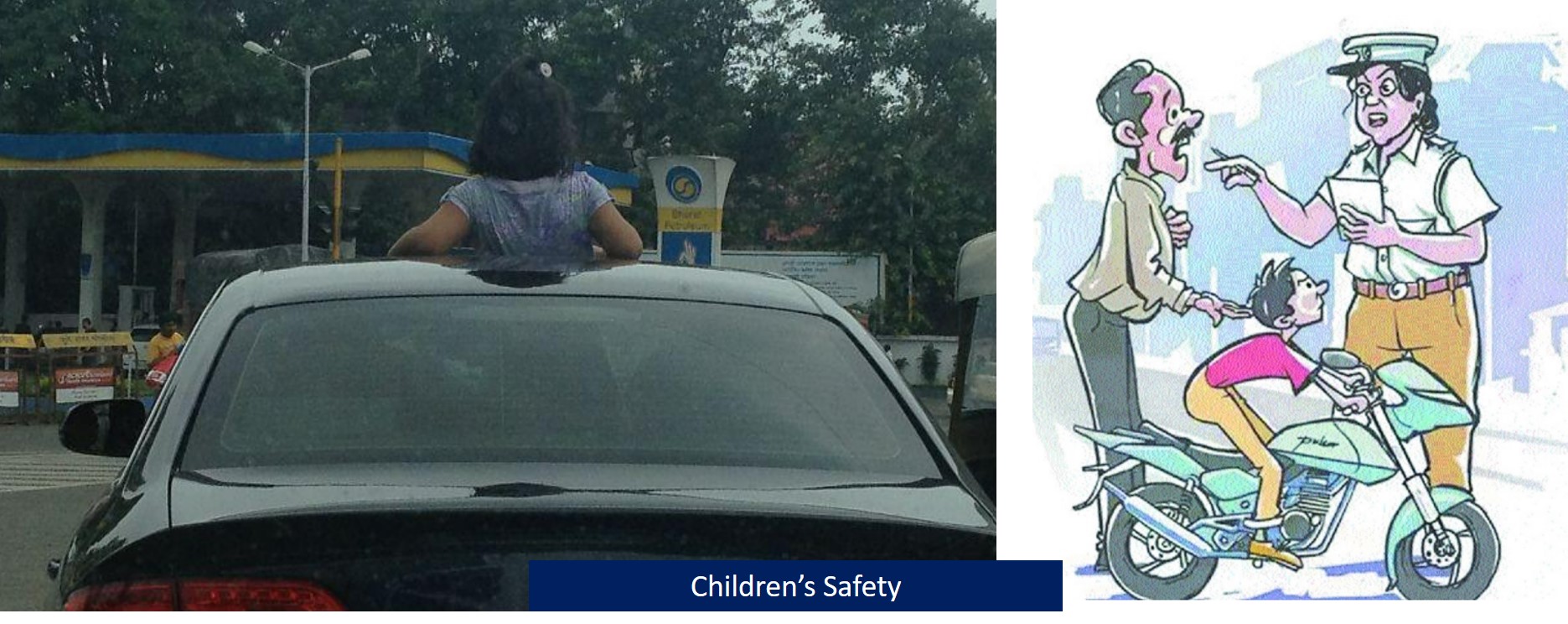

There can be internal factors affecting the driver behaviour: experience and past memory, stress, fatigue, mood. And there can be external factors as well: the road condition and signage, the environment, the group who is with the driver. These factors can lead to a failure to examine risks, poor information gathering, bias in processing information, and therefore risk perception.
The person rationalizes, and justifies the behaviour to himself – he is attending to an urgent matter, it was an important phone call, because ‘everyone is doing it’. Some people may not even realise that what they are doing is risky – it is just normal for them. People have been used to riding without helmets, so the risk perception does not change with the law. And everyone around uses the mobile phone! Sometimes it is to impress peers, although they may not admit it. Thrill seekers knowingly take high risks. Overindulgent parents who encourage children to stand up in the cars, or encourage minors to get into the driver’s seat, believe that their behaviour was safe.
This is not limited to people in the driver’s seat.
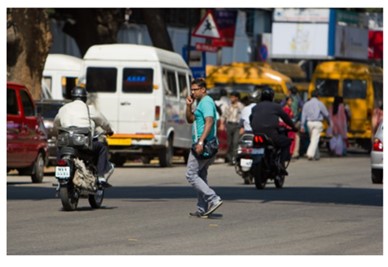 You can see in the pic, a pedestrian is taking some risk with the distracted walking. He has probably done it many times before.
You can see in the pic, a pedestrian is taking some risk with the distracted walking. He has probably done it many times before.
Pedestrians do have a tough time on our roads because the sidewalks are encroached, or the facilities to cross the roads are non-existent. This leads to undue risk especially when crossing broad and busy thoroughfares.
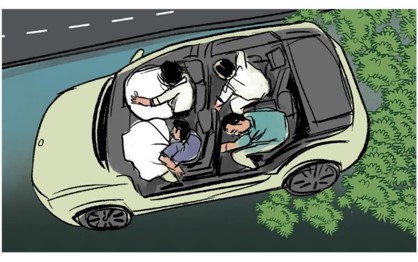
The unfortunate crash that led to the demise of Mr. Cyrus Mistry brought into sharp focus the use of seatbelts in the rear seats. How often do you see people in rear seats wearing seatbelts? It is a rarity. Mr. Mistry may have been accustomed to travel in this manner, and may have covered thousands of km in the rear seat.
 Or take the example of the tragic bus crash near Tumkur in Karnataka. Was it the first time that the people were travelling in the overcrowded bus? Was it the first time that the driver has packed so many passengers in his bus? Most certainly not. The passengers rationalise that they have no other means. The driver and the transport company are keen to make the most of the opportunity for their gains, they are confident of their vehicle and their ability to control it. They can all justify the reason for their action. Plus, they had made the trip numerous times. So why not one more time?
Or take the example of the tragic bus crash near Tumkur in Karnataka. Was it the first time that the people were travelling in the overcrowded bus? Was it the first time that the driver has packed so many passengers in his bus? Most certainly not. The passengers rationalise that they have no other means. The driver and the transport company are keen to make the most of the opportunity for their gains, they are confident of their vehicle and their ability to control it. They can all justify the reason for their action. Plus, they had made the trip numerous times. So why not one more time?
Topsy Turvy In A Split Second
If the first risky attempt results in some injury or a near miss, the person may refrain from such behaviour. But more often than not, this passage is without any hiccups. And then, the behaviour repeats, many times over, to a point when the person has an exaggerated sense of control.
It will take just one fall to the ground from the motorbike to damage the skull. It will be just one instance of a speedy ride spinning out of control. It will be just one instance of the underage driver panicking. Whether in the case of the bus tragedy, or in the case of Mr. Mistry, on the fateful day, it was a split second that turned everything topsy turvy!
And when the moment arrives, it is too late to take evasive action or to make any correction. Extra caution is required to curb the optimism bias, for things can turn topsy turvy in a split second!
Risk Perception and Tolerance
Risk perception is the ability to discern risk, and risk tolerance is the capacity to accept a certain amount of risk ( we often use the term “calculated risk” ).
There is an interesting correlation with the age of the driver. Younger drivers are overconfident because they underestimate the hazard or do not anticipate it. This is due to inexperience. On the contrary, the experienced drivers underestimate the risks because some of them are familiar! Or, as discussed earlier, the repeated experience blunts the sense of risk and exaggerates the sense of control.
It is known that men take more risks on the road compared to women drivers. This is primarily because the risk tolerance levels of women are lower, and there is a strong correlation to the family affiliation. Thrill seekers have a very high risk tolerance, and they knowingly engage in extremely risky behaviour.
What Can We Do About It?
We need safer systems – safer roads, safer vehicles, safer speeds – that will be more forgiving to human errors. But there is no substitute to a safety mindset – safety is not by accident. As my friend Naresh Raghavan ( the author of the Card Driving School Manual for India ; he has recently released his course online for free Indian Driving Rules (Professional Road Safety Course) – YouTube ) says “Driving may be fun. But primarily it is a huge responsibility. A well-trained driver can drive safely through bad roads, bad traffic conditions, bad weather. Good driving is science, don’t leave it to luck”.
The awareness that the road is a shared space, and that we all should be able to continue to enjoy our driving or walking is essential to reduce risky behaviour. Perception of risk is a critical antecedent to at-risk road behaviour. Conventional defensive driver training should be augmented with training to increase self-awareness so as to improve technical driving skills without increasing overconfidence. We suggest the use of toolkits with a set of questions supplemented by videos and images. The drivers can do a self-assessment. Based on the answers, there can be a targeted sensitization. This will help temper their risk perception. The toolkit can also help draw a stronger connection to family and community so that they feel the need to avoid the negative consequences and thus lower their risk tolerance. Fleets ( trucks, buses, taxis ) should certainly implement this on a regular basis.
“Catch them young!” – The sooner we do this in the life of a driver, the better it is. This can be incorporated into the process to grant a driving license, and then at each renewal to help the driver re-calibrate.
If you have any suggestions, I would love to hear from you!
References
- https://www.indiatoday.in/india/story/nitin-gadkari-seatbelts-mandatory-for-passengers-in-rear-seats-of-car-cyrus-mistry-accident-1997204-2022-09-06
- https://www.mid-day.com/mumbai/mumbai-news/article/the-v-and-l-on-the-road-that-claimed-cyrus-mistrys-life-23244463
- https://www.india.com/karnataka/8-dead-20-injured-after-bus-carrying-60-passengers-overturns-in-karnatakas-tumkur-5292865/
- https://www.thecampbellinstitute.org/wp-content/uploads/2017/05/Campbell-Institute-Risk-Perception-WP.pdf
- https://iosh.com/media/5929/presentation-by-tina-on-risk-perception-to-safe-behaviour.pdf

